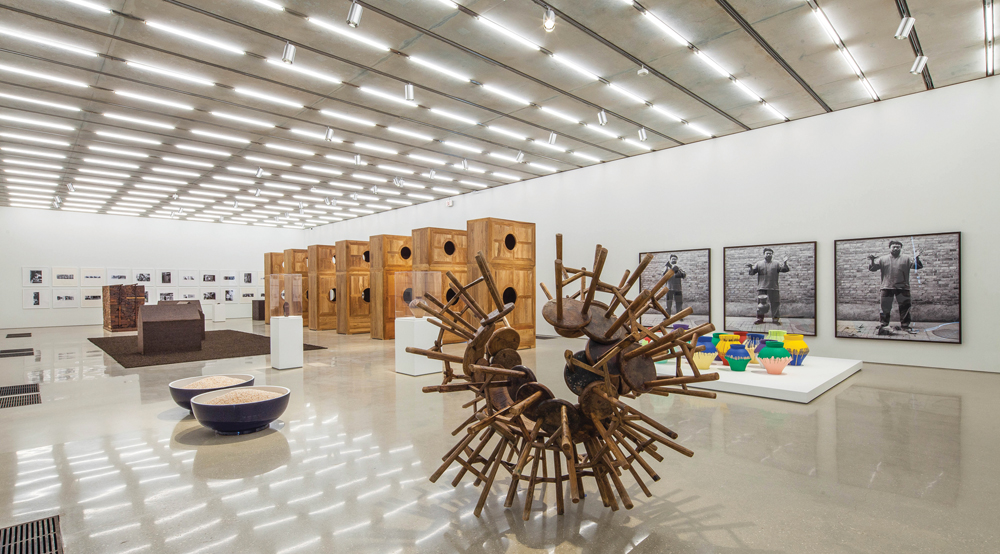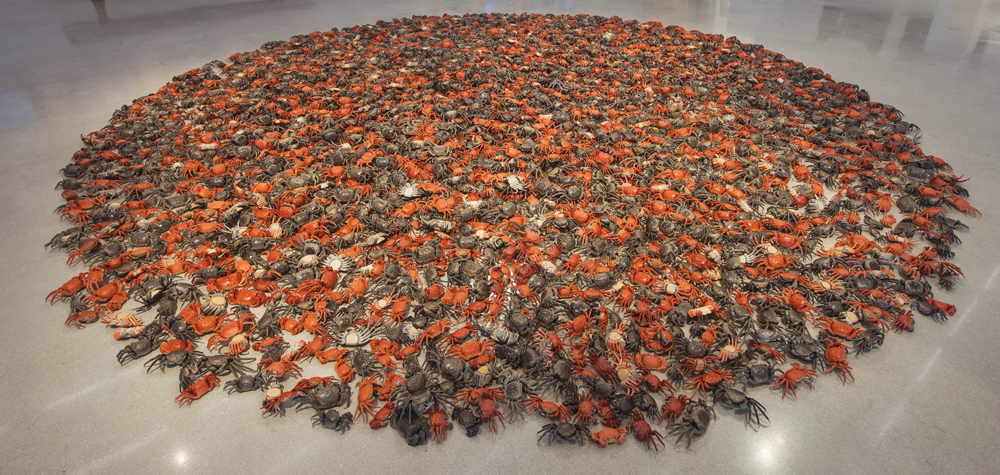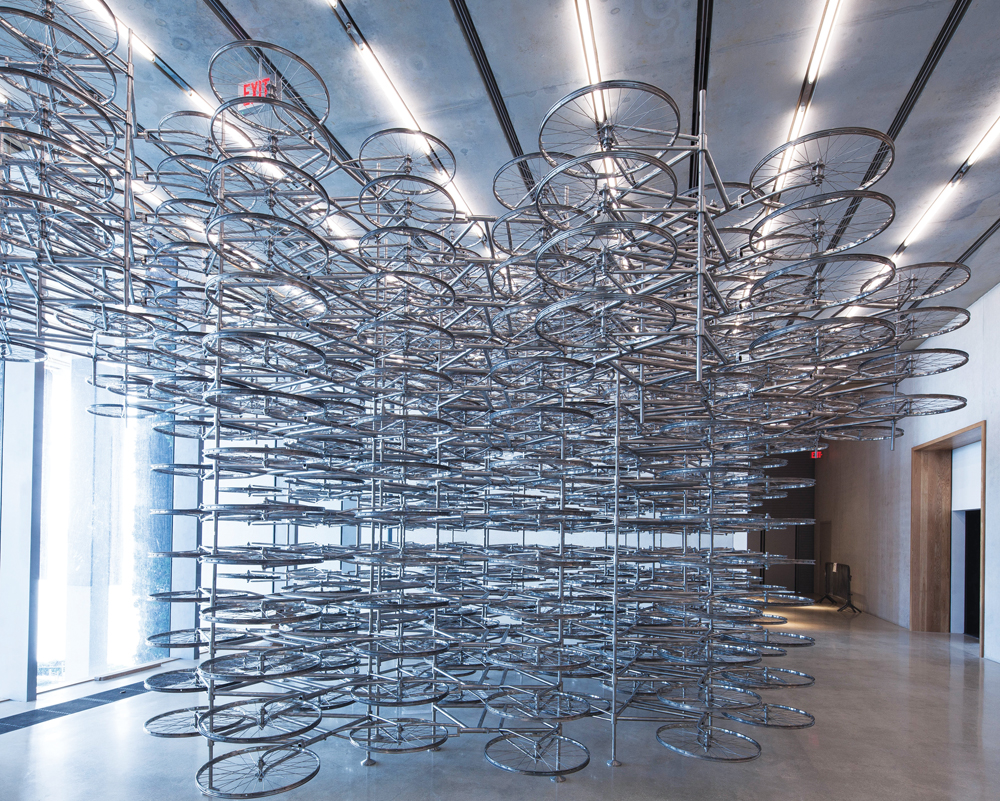« Features
Ai Weiwei: According to What?
By Heike Dempster
“According to What?” the Jasper Johns-inspired title of Ai Weiwei’s exhibition currently on view at the Pérez Art Museum Miami, is a question that runs threadlike through the artist’s work. The thought processes set in motion by this question provide a point of departure for the analysis and understanding of not just Ai’s work but of other cultures and people. Can we understand the “other” from within?
“Ai Weiwei: According to What?” is the first major international survey of Ai’s artistic oeuvre, containing more than 30 works from the past 20 years. His art starts with a dialogue driven by questions about the social, cultural and political positions of his native China and the world at large. Added to the exhibit at PAMM is Ai’s Circle of Animals/Zodiac Heads (2010). The artist’s first major public sculpture project consists of 12 gigantic bronze sculptures referencing the animal heads pillaged from the Yuanmingyuan Palace in 1860.

“Ai Weiwei: According to What?” From top to bottom: Dropping a Han Dynasty Urn, 1995/2009; Colored Vases, 2007-2010. Installation view at Pérez Art Museum Miami. All photos: Daniel Azoulay photography.
Art and activism are interlinked in his work. The impressive and aesthetically marvelous animal heads could never be separated from their meanings as zodiac signs based on Chinese astrology, and they could also never be understood outside the context of the pillaging.
Ai is one of the most recognized and influential artists and activists in the world. He has moved beyond the borders of his native China, beyond the boundaries of the fine art world, and has entered into the realm of contemporary politics and pop culture simultaneously. The artist, activist, architect, designer, publisher and curator has a following of thousands and thousands, especially through his extensive use of social media. With his blog posts and tweets, which have been referred to as “social sculptures”1 by curator Hans Ulrich Obrist, Ai has created a universal context for his work and thoughts that lend power and dynamism to his art.
“Art allows us to ask the right questions through our visual perception or feeling. By doing that, we are able to question the essential elements, our mental processes,”2 says Ai, who is not shy about asking questions, pushing boundaries, disregarding labels and examining social and political structures. Accordingly, he continuously reevaluates his role within those structures while urging others to do the same.

“Ai Weiwei: According to What?” Installation view Pérez Art Museum Miami. Photo: Daniel Azoulay Photography.
Ai first came to international prominence as an artist with his installation Fairytale at Documenta 12 in Kassel in 2007, when he chose 1,001 Chinese citizens of diverse backgrounds to participate in his site-specific work. Overcoming great challenges, the individuals traveled to Germany for this groundbreaking piece, which provided commentary not just on the singularity of personal experiences but also represented the diversity of China and examined notions of individuality versus the collective.
In China, Ai designed the Beijing National Stadium for the Olympics in collaboration with Swiss architects Herzog & de Meuron. His relationship with the Chinese authorities began to deteriorate shortly thereafter when he collected and released the names of the more than 5,000 children who fell victim to the school collapses in the Sichuan earthquake in May 2008. Ai’s defiance of the government’s approach of silence and neglect, his call for responsibility and his questioning of not just the authorities but the value of life in contemporary China changed his situation irrevocably by putting him on the government’s radar. His continued activism and outspokenness subsequently led to his arrest on April 3, 2011, with his 81-day detention and surveillance coming thereafter.
The context and basis for understanding Ai’s work lies ultimately in an understanding of his life experiences, including the Cultural Revolution that defined his childhood, history, and traditional and contemporary Chinese culture-but also, knowledge of globalization and current affairs. Ai goes beyond artistic explorations of human rights, cultural identity and the impact of social and economic instability. He wants to bring forth change, whether directly or indirectly, as he often calls for action through his art and activism. Ai explores life through art to create a continuous dialogue about society. Additionally, he questions and probes the power of art and modes of art making.
Ranging from architecture to design, photography, large-scale sculpture, installation, video and audio, Ai has never had a one-dimensional or limited approach to art. Instead, he sees it as “not a form but a philosophy of society,”3 as something transformative and provocative. His sculptures are often made from modified found objects, suggesting the irreverent nature of the project, as he reconfigures materials in new and evocative ways.
Ai plays on notions of conceptual and minimal art and wants his audience to think of it in contextual terms. His manipulation of traditional Chinese objects and ancient pottery such as the Ming vases Han Dynasty Urn with Coca-Cola Logo (1994), Dropping a Han Dynasty Urn (1995/2009) and Colored Vases (2007-2010) question authenticity and the value of original artwork and play with the notion of producing new ideas through iconoclasm. Ironically, ancient artisan traditions and craftsmanship are also being preserved through the high demand for forgeries. The questions therefore remain: What is authentic? What is original? Ai’s artworks are often created by artisans based on his ideas and concepts. Is the resulting art his work? Notions of art-making have changed with the rise of conceptual contemporary art, and authenticity has become more closely associated with and defined by the conception of an idea rather than the actual creation of it. Through his work, Ai honors and respects traditional craftsmanship while simultaneously presenting updated versions within a contemporary context.
Chinese cultural traditions are intrinsic to Ai’s art, from concept to craftsmanship and material choices. He has worked in ceramics, wood, marble and even pu’er tea and sunflower seeds, both real and re-created out of ceramics. Daily life in China inspires his art, but instead of presenting the expected, Ai has the gift of transforming viewers’ perceptions of objects with his play on context. Original meanings can be highlighted within unusual surroundings, and artistic form can change something seemingly mundane or ordinary into a profoundly impactful work of art.

Ai Weiwei, He Xie, 2011, porcelain. Collection of the artist. Installation view at Pérez Art Museum Miami.
Ai’s art transcends the dualities between East and West, focusing on fundamental questions about the interrelation between art, culture, society, and individual experience. His contribution to contemporary art is deep and diverse. After 10 years in the U.S., mainly in New York, Ai returned to Beijing at a time when the notion of conceptual art had not yet had an impact on contemporary art in China. His work, as an artist and publisher, starting in 1994 with his Black Cover Book in collaboration with Xu Bing and Zeng Xiaojun, influenced and inspired many young Chinese artists to explore conceptualism and new media and engage in a more experimental artistic practice.
In 1997, Ai founded the China Art Archives & Warehouse and started curating exhibitions, such as “Fuck Off” in 2000, in conjunction with the third Shanghai Biennale. Essentially, through his wide-ranging work, awareness and understanding of China and knowledge of architecture and art, Ai made substantial contributions to raising the awareness of and building an infrastructure for contemporary Chinese art.

Ai Weiwei, Circle of Animals/Zodiac Heads (detail), 2010, bronze. Private Collection. Installation view at Pérez Art Museum Miami.
China has endured periods of intense political and cultural change, such as the Cultural Revolution, which enforced communism and removed capitalist, traditional and cultural elements, with only modest liberalization coming after the mid-1970s. This dichotomy has created a complex and unique society that Ai has lived through, experiencing the impact of the Cultural Revolution firsthand as a child. He has observed China from, in anthropological terms, an ethical as well as emic perspective. He has lived in China as well as the United States, which affords him a dual perspective. His work captures change, the past, present and future. He is part of today’s dialogue about what aspects of Chinese culture to preserve, what to reform and what impact the positive and negative changes may have on Chinese society and the world at large. Ai adds an anthropological aspect to his art through his examinations of the transformation of landscape, cityscape, daily life, cultural values and identity construction.
Ai keeps his finger on the pulse of the times, and the incredible impact he has had on contemporary art and beyond is partially due to his aforementioned use of the Internet and social media. His powerful voice is heard by millions even without direct access to his art. Through social media, Ai shares his views, discusses current affairs and captures life in a constant stream of images in an almost poetic way. He encourages people to think, stand up for what they believe and share individual stories as part of the collective identity and life experience. Through social media, Ai has recruited volunteers to help collect names of the school children who would have otherwise remained nameless to the world. People have come together in his name to become part of the greater good, care about one another, help tell each other’s stories, be part of the narrative. Just like in Ai’s art, each fragment is always an important part of the whole, a manifestation of the objective awareness of history, time, society and reality. Every fragment, every individual, matters, just as each single pearl or sunflower seed can constitute a work of art in itself or be part of a bigger installation.
There may be as many different answers as voices asking “According to What?”-but the important aspect is that people keep asking the question. According to Ai, “An artist can only raise new question and offer insight into social change after reflecting on the feelings of the time. Rather than thinking of my projects as art, they attempt to introduce a new condition, a new means of expression, or a new method of communicating. If these possibilities didn’t exist, I wouldn’t feel the need to be an artist.”4
NOTES
1. Ai Weiwei Speaks with Hans Ulrich Obrist. London: Penguin Global, 2011. p. 8
2. Kataoka, Mami, “According to What? A Questioning Attitude.” Ai Weiwei: According to What? New York: Prestel USA, 2012, p. 9.
3. See, <http://www.pamm.org/exhibitions/ai-weiwei-according-what>
4. Brougher, Kerry, “Reconsidering Reality: An Interview with Ai Weiwei.” Ai Weiwei: According to What? New York: Prestel USA, 2012, p. 38.




































Leave a Reply
You must be logged in to post a comment.